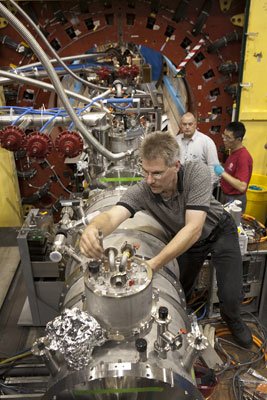Aug 25 2009
Scientists working on the proposed International Linear Collider (ILC) know exactly what they want it to do -- collide tightly focused beams of subatomic particles with unprecedented energy, recreating conditions during the big bang and unlocking the mysteries of the universe's origins.
 Daniel Sabol, research support specialist, prepares cryogenic connections during the installation of a diagnostic superconducting wiggler magnet, part of the CesrTA program. In the background are Tobey Moore, vacuum technician, and Yulin Li, vacuum scientist. Jason Koski/University Photography
Daniel Sabol, research support specialist, prepares cryogenic connections during the installation of a diagnostic superconducting wiggler magnet, part of the CesrTA program. In the background are Tobey Moore, vacuum technician, and Yulin Li, vacuum scientist. Jason Koski/University Photography
Exactly how to do that is another story.
Still in early stages and several years away from being built, the ILC is garnering key design insights from Cornell scientists, who are creating a prototype of a major ILC component called a damping ring. The two-year project, which involves reconfiguring Cornell's existing electron storage ring (CESR) into a damping ring, is called CESR Test Accelerator (CesrTA).
"In the case of the damping rings, there is some fundamental physics that we have to make sure we deal with properly, or we won't be able to succeed in the final design of the ILC," said CESR research associate Mark Palmer, CesrTA's project director.
The ILC would be a complementary machine to the Large Hadron Collider (LHC), a proton-proton collider that is operating at CERN in Geneva, Switzerland. Particles detected by the LHC would then be analyzed more closely by the ILC. Final design plans for the ILC will likely be completed in 2012.
Damping rings are circular accelerators in which beams of electrons or their anti-particles, called positrons, are cooled and focused before being accelerated down a straightaway at nearly the speed of light, and collided with an oncoming beam. They are an essential part of the ILC's design; to hurl 10 billion electrons and positrons toward each other, particles must be densely packed into a small, tight beam -- a condition called low beam emittance.
"We're approaching emittance values that have not been very well studied in damping rings of this type before," said Jim Shanks, a physics graduate student working on CesrTA.
The CesrTA scientists are facing numerous challenges in developing the perfect damping ring. They are outfitting CESR with devices called wigglers -- magnets that "wiggle" a beam back and forth to burn off energy in the form of synchrotron radiation and help cool and focus electron or positron beams.
But the synchrotron radiation also causes electrons to be emitted from the beam pipe wall. These electrons can accumulate in the beam pipe and interact with the circulating electron or positron beam. This effect, called electron clouds, causes the beam to scatter. Mitigating the electron cloud effect is a key goal of CesrTA. The problem isn't new; other researchers have found that electron clouds have severely hampered their experiments.
CesrTA scientists have placed 12 wigglers at various locations in CESR, rigging several with different mechanisms to defeat the electron cloud effect. One wiggler is coated with titanium nitride. Another is grooved. All have detectors that measure the size of the cloud and tell whether the strategy is working.
The electron storage ring has been configured for CesrTA since early 2008. Since then, CesrTA scientists have been sharing the storage ring with Cornell High Energy Synchrotron Source scientists, who use radiation from the beams as X-ray light sources.
The CesrTA program, funded by the National Science Foundation and the U.S. Department of Energy, is an international collaboration of scientists from Argonne National Laboratory, Brookhaven National Laboratory, California Polytechnic State University, the Cockcroft Institute, the European Organization for Nuclear Research (CERN), Fermi National Accelerator Laboratory, the Japanese High Energy Accelerator Research Organization (KEK), the Laboratori Nazionali di Frascati, Lawrence Berkeley National Laboratory, and SLAC National Accelerator Laboratory.